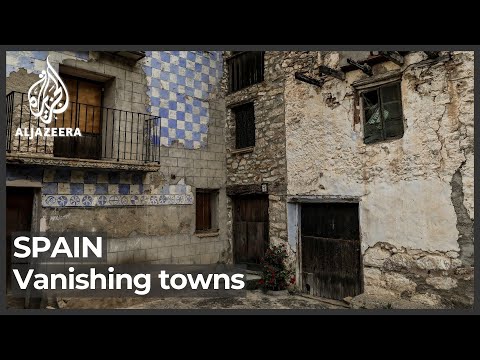
En las últimas décadas, España ha experimentado un declive en su población que ha dejado a muchas zonas del país con una sensación de vacío. ¿Por qué está sucediendo esto y cuáles son las consecuencias? En este artículo, exploraremos las causas detrás de la disminución de la población en España y cómo esto ha impactado en la vida de las personas que viven en estas áreas con baja densidad poblacional.
Why is the majority of Spain empty
Spain is a country with a diverse landscape, rich history, and a vibrant culture. However, despite all its beauty and attractions, Spain is facing a significant population decline. The majority of Spain’s population lives in urban areas, leaving vast empty spaces in rural areas. In this article, we will explore the reasons behind Spain’s population decline and the implications of this trend on the country’s future.
Reasons behind the Population Decline
The population decline in Spain can be attributed to several factors. Firstly, the country has one of the lowest birth rates in Europe, with an average of 1.3 children per woman. This means that the population is not replenishing itself, and there are fewer young people to replace the aging population.
Secondly, the economic crisis of 2008 hit Spain hard, resulting in high unemployment rates and a significant drop in the standard of living. This led many young people to migrate to other countries in search of better job opportunities, leaving behind an aging population.
Thirdly, Spain has a large immigrant population, but many of them have left the country due to the economic crisis and the lack of job opportunities. This has contributed to the decline in the population, particularly in rural areas where immigrants were more likely to settle.
Implications of the Population Decline
The population decline in Spain has numerous implications for the country’s economy, society, and future. Firstly, the aging population means that there are fewer people in the workforce, resulting in a shortage of skilled workers and a reduction in economic productivity.
Secondly, the decline in population has led to the abandonment of rural areas, leaving vast empty spaces. This has implications for the environment, as well as the social fabric of these areas, where communities are disappearing.
Thirdly, the population decline has implications for the country’s healthcare system, as there are fewer people to support it. This, in turn, puts pressure on the government to provide better healthcare services, which can be challenging in times of economic uncertainty.
What percentage of Spain is unpopulated
Spain is a country located in southwestern Europe, with a total area of approximately 505,990 square kilometers. However, despite its large size, a significant portion of Spain remains unpopulated.
According to data from the National Institute of Statistics, in 2020, Spain had a population of approximately 47 million inhabitants, with a population density of around 93 people per square kilometer. However, despite this relatively high population density, around 50% of Spain’s territory is unpopulated.
This large percentage of unpopulated land is due to several factors. Firstly, Spain’s geography is characterized by a diverse range of landscapes, including mountain ranges, deserts, and forests, which are often difficult to access and therefore unsuitable for large-scale human habitation. Additionally, the country’s history of rural depopulation, particularly in the 20th century, has led to the abandonment of many rural areas, which has contributed to the high percentage of unpopulated land.
It is important to note that while Spain’s unpopulated areas may appear to be a negative aspect of the country, they also provide a number of benefits. These include opportunities for outdoor activities such as hiking, camping, and nature photography, as well as the preservation of important ecosystems and natural habitats.
What is the uninhabited land in Spain
Spain is a beautiful country with a rich history, diverse culture, and breathtaking landscapes. However, despite its many attractions, Spain is facing a serious problem: depopulation. The country’s population has been declining steadily over the past few decades, and this trend shows no sign of slowing down. One of the consequences of this trend is the existence of uninhabited land in Spain.
Uninhabited land refers to areas that have no permanent residents. This could be due to various reasons, including economic decline, natural disasters, or simply a lack of interest from people. In Spain, there are several regions that have been affected by depopulation, resulting in vast stretches of uninhabited land. These regions are mainly located in the north and east of the country, including Galicia, Asturias, Aragon, and Castilla y León.
The reasons for depopulation and the resulting uninhabited land in Spain are complex and multifaceted. One of the main factors is the aging population. Spain has one of the oldest populations in Europe, with a low birth rate and a high life expectancy. This demographic shift has put a strain on the country’s social services and infrastructure, making it difficult for younger generations to thrive and build a life in rural areas.
Economic factors are also a major contributor to depopulation and the resulting uninhabited land in Spain. Many rural areas have suffered from a lack of investment and job opportunities, leading to a decline in the local economy. This has forced many young people to move to urban areas in search of work and better living conditions, leaving behind empty villages and towns.
The impact of uninhabited land in Spain is significant. It can lead to a loss of cultural heritage, as historic buildings and traditions are abandoned and forgotten. It can also have environmental consequences, as the lack of human presence can affect wildlife and natural habitats. Moreover, uninhabited land can have economic repercussions, as it can discourage tourism and foreign investment.
En conclusión, la disminución de la población en España es un fenómeno complejo que involucra múltiples factores económicos, sociales y demográficos. El envejecimiento de la población, la emigración de jóvenes y la falta de oportunidades en las áreas rurales son algunos de los desafíos a los que se enfrenta España. Sin embargo, existen medidas que se pueden tomar para combatir este problema, como la implementación de políticas de apoyo a las familias y a la natalidad, la promoción de la innovación y el emprendimiento en las zonas rurales y la facilitación de la inmigración selectiva para cubrir las necesidades laborales de ciertos sectores. Si se toman medidas efectivas, España puede revertir esta tendencia y mantener su población e identidad cultural a largo plazo.





